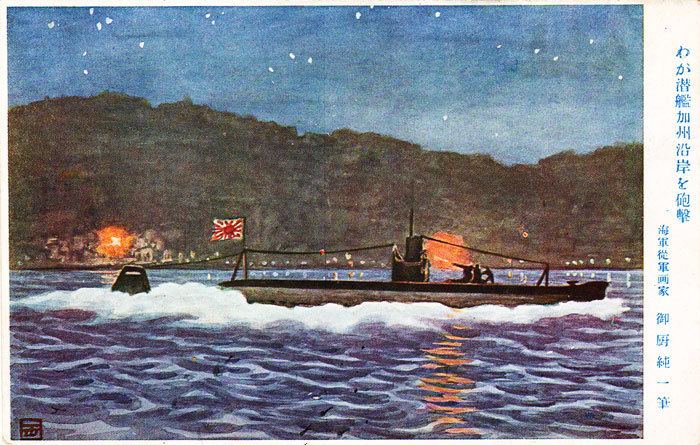N/A Kozo Nishino Date 23 February 1942 | ||
Similar | ||
The Bombardment of Ellwood during World War II was a naval attack by a Japanese submarine against United States coastal targets near Santa Barbara, California. Though damage was minimal, the event was key in triggering the West Coast invasion scare and influenced the decision to intern Japanese-Americans. The event also marked the first shelling of the North American mainland during the conflict.
Contents
Background

Following the attack on Pearl Harbor, Hawaii, seven Japanese submarines patrolled the American West Coast. They sank two merchant ships and damaged six more, skirmishing twice with U.S. Navy air or sea forces. By the end of December, the submarines had all returned to friendly waters to resupply. However, several had gone to Kwajalein, and would pay a return visit to American waters. One of these was the Imperial Japanese Navy submarine I-17. The I-17 displaced 3,654 long tons (3,713 t) when submerged and was 365 ft 6 in (111.40 m) long. Her armament included six 20 in (510 mm) torpedo tubes and 17 torpedoes, plus a 14-cm deck gun. She carried 101 officers and men, captained by Commander Kozo Nishino.

A naval reserve officer, Nishino commanded a merchant ship which sailed through the Santa Barbara Channel before the war. His ship had once stopped at the Ellwood Oil Field to take on a cargo of oil. Unfortunately, while walking to a welcoming ceremony, Nishino tripped and fell into a patch of prickly pear cactus (now below Fairway 11 of the Sandpiper Golf Course). A group of oil workers saw the Japanese officer having cactus spines pulled from his backside and began to laugh. As a result, Nishino chose the oil field as the target for his deck gun. Most of the damage he inflicted was within 300 m (980 ft) of the spot he had fallen.
Bombardment
About 1900 hours (7:00 pm) on 23 February 1942, the I-17 came to a stop opposite the Ellwood field. Nishino order his deck gun cleared for action. Its crew took aim at a Richfield aviation fuel tank just beyond the beach. The Japanese opened fire about 15 minutes later, the first rounds landing near a storage facility. The oil field's workmen had mostly returned home, but a skeleton crew on duty heard the rounds impact. They took it to be an internal explosion, until one man spotted the I-17 in the distance. An oiler named G. Brown later told reporters that the enemy submarine looked so big to him he thought it must be a cruiser or a destroyer, until he realized that just one gun was firing.
Nishino soon ordered his men to aim at the second storage tank. Brown and the others called the police, as the Japanese shells continued to fall around them.
Firing in the dark on a submarine buffeted by waves, it was inevitable that many rounds would miss their target. One round passed over Wheeler's Inn, whose owner Laurence Wheeler promptly called the Santa Barbara County Sheriff's Office. A deputy sheriff assured him that warplanes were already on their way, but none ever arrived. The Japanese shells destroyed a derrick and a pump house, while the Ellwood Pier and a catwalk suffered minor damage. After 20 minutes, the gunners ceased fire and the submarine sailed away. Estimates of the number of explosive shells fired ranged from a minimum of 12 to as many as 25. Even though he caused only light damage, Nishino had achieved his purpose, which was to spread fear along the American west coast.
Reverend Arthur Basham of Montecito called the police to claim he had seen the enemy submarine from his home. He said the I-17 turned south towards Los Angeles, apparently flashing signal lights to someone on shore. In reality, the I-17 had sailed west, returning to Japan in safety.
Aftermath
Since several people in Santa Barbara claimed to have seen "signal lights", a blackout was ordered for the rest of the night. The reports of Nishino's attack caused hundreds to flee inland, and the baseless claims of "signals" were used to justify Franklin D. Roosevelt's controversial internment of Japanese-Americans (U.S. citizens included), which began just one week later.
One night after the Elwood attack, the mysterious Battle of Los Angeles took place. In response to claimed sightings of "enemy aircraft", anti-aircraft batteries opened fire all across the city, causing panic among its residents. Whether anything actually had been spotted, and if so what it was, is still debated.
Japanese submarines would continue to conduct occasional attacks against allied shipping off the U.S. coast during the remainder of war. Sent to American waters in hopes of targeting warships, the submarines managed to sink only a handful of merchant ships, besides conducting minor attacks on shore targets. These consisted of a bombardment of Fort Stevens on the Columbia River, an attack on a Canadian lighthouse on Vancouver Island,and two minor air raids launched from a submarine in an attempt to start forest fires in southwest Oregon.
